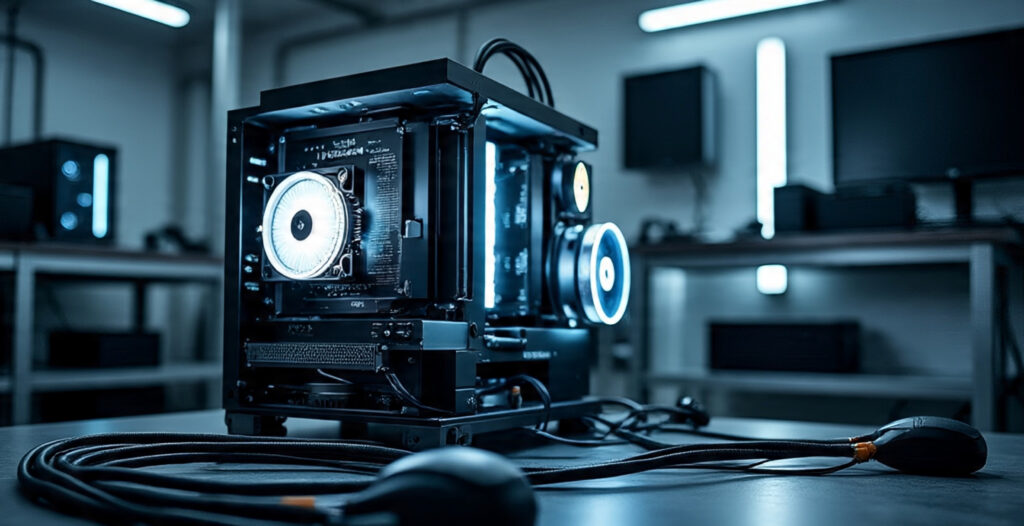Finding the best bitcoin mining hardware has become increasingly critical as Bitcoin’s network difficulty continues to rise and mining competition intensifies. Whether you’re a seasoned miner looking to upgrade your operation or a newcomer seeking the most profitable entry point, choosing the right mining equipment can make or break your profitability. In this comprehensive guide, we’ll explore the top-performing ASIC miners available in 2025, analyze their hash rates, power consumption, and return on investment potential. From budget-friendly options to industrial-grade powerhouses, we’ll help you identify the best bitcoin mining hardware that aligns with your budget, electricity costs, and mining goals. The landscape of cryptocurrency mining continues to evolve rapidly, making it essential to stay informed about the latest hardware innovations and market trends.
Understanding Bitcoin Mining Hardware Evolution
The cryptocurrency mining industry has undergone dramatic transformations since Bitcoin’s inception. Early miners could successfully mine Bitcoin using standard CPUs and graphics cards, but those days are long gone. Today’s competitive mining environment demands specialized Application-Specific Integrated Circuits (ASICs) designed exclusively for Bitcoin’s SHA-256 algorithm.
Modern Bitcoin mining hardware represents the pinnacle of semiconductor engineering, featuring cutting-edge chip architectures that maximize hash rate while minimizing power consumption. The continuous arms race among manufacturers like Bitmain, MicroBT, and Canaan has resulted in increasingly efficient miners that can process trillions of hash calculations per second.
Understanding the technical specifications and performance metrics of different miners is crucial for making informed purchasing decisions. Hash rate, measured in terahashes per second (TH/s), indicates how many calculations a miner can perform. Power efficiency, measured in watts per terahash (W/TH), determines operational costs and profitability.
Top Bitcoin Mining Hardware in 2025
Flagship ASIC Miners Leading the Market
The current generation of Bitcoin miners showcases remarkable improvements in both performance and efficiency compared to previous models. Leading manufacturers have introduced miners capable of achieving hash rates exceeding 200 TH/s while maintaining competitive power consumption ratios.
Bitmain Antminer S21 Series The Antminer S21 Pro represents Bitmain’s latest flagship offering, delivering exceptional performance with a hash rate of 234 TH/s and power consumption of approximately 3,510 watts. This translates to an impressive efficiency ratio of 15 J/TH, making it one of the most energy-efficient miners available. The S21 Pro features advanced cooling systems and robust build quality designed for continuous 24/7 operation.
MicroBT Whatsminer M60S+ MicroBT’s Whatsminer M60S+ stands as a formidable competitor, offering 228 TH/s with 3,344 watts power consumption. The miner achieves an efficiency of 14.7 J/TH, positioning it among the top performers in terms of energy efficiency. Its innovative cooling design and reliability have made it popular among large-scale mining operations.
Canaan AvalonMiner 1466 Canaan’s AvalonMiner 1466 provides 150 TH/s with 3,420 watts consumption, resulting in a 22.8 J/TH efficiency ratio. While not the most efficient option available, it offers competitive pricing and proven reliability, making it attractive for miners seeking cost-effective solutions.
Mid-Range Mining Solutions
For miners with moderate budgets or those testing the waters before major investments, several mid-range options provide excellent value propositions without compromising significantly on performance.
Bitmain Antminer S19j Pro+ The S19j Pro+ delivers 122 TH/s with 3,355 watts consumption, achieving 27.5 J/TH efficiency. Despite being an older generation model, its proven track record and lower acquisition costs make it appealing for budget-conscious miners.
MicroBT Whatsminer M50S++ With 126 TH/s and 3,276 watts consumption, the M50S++ offers 26 J/TH efficiency. This miner strikes an excellent balance between performance, reliability, and affordability, making it suitable for small to medium-sized operations.
Best Bitcoin Mining Hardware for Different Budgets
Premium High-Performance Options
Large-scale mining operations and investors seeking maximum returns often gravitate toward premium hardware that justifies higher upfront costs through superior performance and efficiency. These top-tier miners typically feature the latest chip technology, advanced cooling systems, and robust construction designed for intensive use.
Premium miners like the Antminer S21 Pro and Whatsminer M60S+ command higher prices but deliver proportionally better hash rates and energy efficiency. The improved performance translates to higher daily Bitcoin earnings and faster return on investment, particularly important given Bitcoin’s increasing network difficulty.
When evaluating premium options, consider factors beyond raw specifications. Build quality, manufacturer warranty, availability of replacement parts, and technical support significantly impact long-term profitability and operational stability.
Budget-Friendly Alternatives
Newcomers to Bitcoin mining or those with limited capital can still participate profitably by selecting well-researched budget alternatives. While these miners may not achieve the highest hash rates or best efficiency ratios, they can provide positive returns when operated under favorable conditions.
Older generation miners like the Antminer S19 series or Whatsminer M30S++ models remain viable options for cost-conscious buyers. These miners, while less efficient than current flagships, often trade at significantly lower prices on secondary markets.
Consider refurbished or used mining hardware from reputable sellers, but exercise caution regarding warranty coverage and remaining operational lifespan. Thoroughly research the seller’s reputation and return policies before committing to used equipment purchases.
Profitability Analysis and ROI Calculations

Factors Affecting Mining Profitability
Bitcoin mining profitability depends on numerous variables that fluctuate constantly. Understanding these factors enables miners to make informed decisions and optimize their operations for maximum returns.
Bitcoin Price Volatility Bitcoin’s market price directly impacts mining revenue, as miners receive Bitcoin payments for successfully mining blocks. Higher Bitcoin prices increase mining profitability, while price declines reduce returns. Successful miners often develop strategies to hedge against price volatility through various financial instruments.
Network Difficulty Adjustments Bitcoin’s network automatically adjusts mining difficulty approximately every two weeks to maintain consistent block times. Increasing difficulty reduces individual miner rewards, while decreasing difficulty improves profitability. Network hash rate growth typically correlates with difficulty increases.
Electricity Costs Power consumption represents the largest ongoing expense for Bitcoin miners. Electricity rates vary significantly by location, with some regions offering rates below $0.05 per kWh while others exceed $0.20 per kWh. Miners in high-cost electricity areas must achieve superior efficiency to remain profitable.
ROI Calculation Methodology
Calculating return on investment for Bitcoin mining hardware requires comprehensive analysis of all costs and projected revenues over time. Accurate ROI calculations help miners compare different hardware options and make informed purchasing decisions.
Initial Investment Costs Include the miner purchase price, shipping costs, import duties (if applicable), and any necessary infrastructure investments such as electrical upgrades or cooling systems. Some miners may require additional power supply units or specialized electrical connections.
Ongoing Operational Expenses Factor in electricity costs, internet connectivity, maintenance expenses, and facility costs (rent, insurance, security). Large-scale operations may incur additional expenses for staff, monitoring systems, and professional services.
Revenue Projections Estimate daily Bitcoin earnings based on current hash rate, network difficulty, and Bitcoin price. Use conservative projections that account for potential difficulty increases and price volatility. Most mining calculators provide helpful baseline estimates, but incorporate safety margins for unexpected changes.
Power Efficiency and Electricity Considerations
Understanding Power Consumption Metrics
Power efficiency stands as one of the most critical factors determining long-term mining profitability. Miners with superior efficiency ratios generate more Bitcoin per kilowatt-hour consumed, providing competitive advantages in markets with rising electricity costs or increasing network difficulty.
Modern Bitcoin miners typically consume between 3,000 to 3,500 watts, roughly equivalent to a large household appliance running continuously. The difference between efficient and inefficient miners can amount to hundreds of dollars monthly in electricity costs, significantly impacting overall profitability.
When evaluating power efficiency, consider both the stated manufacturer specifications and real-world performance reports from other miners. Environmental factors such as ambient temperature and altitude can affect actual power consumption and hash rate performance.
Optimizing Electrical Infrastructure
Successful Bitcoin mining operations require robust electrical infrastructure capable of handling continuous high-power loads. Most residential electrical systems require upgrades to support even single miners, while larger operations demand industrial-grade electrical installations.
Voltage and Phase Requirements Many high-performance miners operate on 220V or 240V power, requiring appropriate electrical outlets and wiring. Three-phase power systems offer advantages for large-scale operations but may not be available in all locations.
Power Distribution and Safety Implement proper electrical protection including circuit breakers, surge protection, and ground fault protection. Professional electrical installation ensures safety and compliance with local codes while minimizing fire risks and equipment damage.
Load Balancing Distribute mining loads across multiple circuits to prevent overloading individual breakers. Consider power factor correction equipment for large installations to improve electrical efficiency and reduce utility costs.
Cooling and Environmental Requirements
Thermal Management Strategies
Bitcoin mining hardware generates substantial heat during operation, requiring effective cooling systems to maintain optimal performance and prevent damage. Inadequate cooling can reduce hash rates, increase power consumption, and shorten equipment lifespan.
Air Cooling Solutions Most residential and small-scale mining operations rely on air cooling using fans and ventilation systems. Ensure adequate airflow through mining areas and consider exhaust fans to remove hot air. Ambient temperature significantly affects cooling requirements and mining performance.
Immersion Cooling Systems Large-scale operations increasingly adopt immersion cooling systems that submerge mining hardware in specialized dielectric fluids. These systems provide superior heat removal, reduce noise levels, and enable higher hash rate density in smaller spaces.
Environmental Controls Monitor temperature and humidity levels continuously using appropriate sensors and control systems. Maintain ambient temperatures below 35°C (95°F) for optimal performance, with lower temperatures generally improving efficiency and reliability.
Noise Management
Bitcoin miners generate significant noise levels, typically ranging from 70 to 80 decibels during operation. Residential miners must consider noise impacts on neighbors and household members, while commercial operations may face noise ordinance restrictions.
Sound Dampening Techniques Install acoustic enclosures, sound-dampening materials, or locate miners in isolated areas to reduce noise transmission. Some miners offer quiet modes that reduce fan speeds and noise levels at the cost of slightly reduced performance.
Operational Scheduling Consider operating schedules that minimize noise during sensitive hours, particularly in residential areas. Some electricity providers offer time-of-use rates that make night operation more economical while reducing daytime noise concerns.
Setting Up Your Mining Operation
Site Preparation and Infrastructure
Establishing a successful Bitcoin mining operation requires careful planning and preparation of physical infrastructure. Whether setting up a home-based operation or commercial facility, proper site preparation ensures optimal performance, safety, and longevity of mining equipment.
Space Requirements Calculate space requirements based on mining hardware dimensions and necessary clearances for airflow and maintenance access. Standard ASIC miners typically require 2-3 feet of clearance on air intake and exhaust sides for proper cooling.
Structural Considerations Evaluate floor loading capacity, as mining equipment can be surprisingly heavy. Industrial miners may weigh 30-40 pounds each, requiring adequate structural support for rack-mounted installations.
Network Connectivity Ensure reliable internet connectivity with sufficient bandwidth and minimal downtime. While miners don’t require high bandwidth, connection stability is crucial for maintaining consistent hash rate contribution to mining pools.
Security and Insurance Considerations
Bitcoin mining hardware represents valuable assets requiring appropriate security measures and insurance coverage. Theft, natural disasters, and equipment failures can result in significant financial losses without proper protection.
Physical Security Implement appropriate security measures including locks, security cameras, alarm systems, and restricted access controls. Consider the visibility of mining operations from public areas and potential attractiveness to thieves.
Insurance Coverage Consult with insurance providers regarding coverage for mining equipment and operations. Standard homeowner’s or commercial policies may not adequately cover mining-specific risks or equipment values.
Backup and Redundancy Develop contingency plans for power outages, equipment failures, and network connectivity issues. Uninterruptible power supplies (UPS) can provide brief backup power during outages, while spare equipment enables quick replacement of failed miners.
Mining Pool Selection and Configuration

Choosing the Right Mining Pool
Individual Bitcoin miners rarely mine blocks independently due to network difficulty levels. Mining pools combine hash power from multiple miners, providing more consistent returns through shared block rewards distributed proportionally to contributed hash power.
Pool Selection Criteria Evaluate mining pools based on fees, payout methods, geographical location, reputation, and reliability. Lower fees increase net returns, while reliable pools minimize downtime and lost mining opportunities.
Popular Mining Pool Options Major mining pools include Antpool, F2Pool, ViaBTC, and SlushPool, each offering different fee structures and features. Research pool statistics, payout histories, and user reviews before making selection decisions.
Pool Configuration Configure miners with appropriate pool settings including server addresses, worker names, and backup pools. Most miners support multiple pool configurations with automatic failover capabilities to maintain continuous operation.
Monitoring and Optimization
Successful mining operations require continuous monitoring and optimization to maximize profitability and identify potential issues before they impact performance.
Performance Monitoring Tools Utilize monitoring software and dashboards that track hash rates, temperatures, power consumption, and earnings. Many mining pools provide comprehensive statistics and mobile applications for remote monitoring.
Maintenance Schedules Develop regular maintenance schedules including cleaning dust from fans and heat sinks, checking electrical connections, and updating firmware. Preventive maintenance extends equipment lifespan and maintains optimal performance.
Performance Optimization Fine-tune mining settings including frequency, voltage, and fan curves to optimize the balance between hash rate, power consumption, and operating temperatures. Some miners offer automatic tuning features that optimize performance based on environmental conditions.
Future of Bitcoin Mining Hardware
Technological Innovations
The Bitcoin mining hardware industry continues evolving rapidly, driven by competition among manufacturers and demands for improved efficiency and performance. Understanding upcoming technological trends helps miners make informed investment decisions and plan future upgrades.
Next-Generation Chip Technology Semiconductor manufacturers are developing increasingly advanced chips using smaller manufacturing processes (7nm, 5nm, 3nm) that enable higher transistor density and improved power efficiency. These advances translate directly to better mining performance and lower operational costs.
Advanced Cooling Solutions Innovative cooling technologies including liquid cooling, immersion cooling, and advanced thermal interface materials enable higher hash rate density and improved reliability. These cooling solutions become increasingly important as miners generate more heat per unit.
Artificial Intelligence Integration Future mining hardware may incorporate AI-powered optimization that automatically adjusts performance parameters based on environmental conditions, electricity costs, and network difficulty to maximize profitability.
Market Trends and Predictions
The Bitcoin mining hardware market continues growing and evolving, influenced by Bitcoin adoption, regulatory changes, environmental concerns, and technological advances. Successful miners stay informed about market trends and adapt their strategies accordingly.
Sustainability Focus Increasing emphasis on environmental sustainability drives development of more energy-efficient miners and adoption of renewable energy sources. Miners using clean energy may gain competitive advantages through lower operational costs and improved public perception.
Regulatory Developments Government regulations regarding cryptocurrency mining vary by jurisdiction and continue evolving. Stay informed about local regulations and potential changes that could impact mining operations and profitability.
Conclusion
Selecting the best bitcoin mining hardware requires careful analysis of your specific situation, including budget constraints, electricity costs, facility requirements, and profitability goals. The mining landscape continues evolving rapidly, with new hardware generations offering improved efficiency and performance while older models become more affordable on secondary markets.
Success in Bitcoin mining depends not only on choosing efficient hardware but also on optimizing operational factors like cooling, electricity costs, and maintenance practices. Whether you’re starting with a single miner or planning a large-scale operation, thorough research and careful planning are essential for achieving positive returns.


